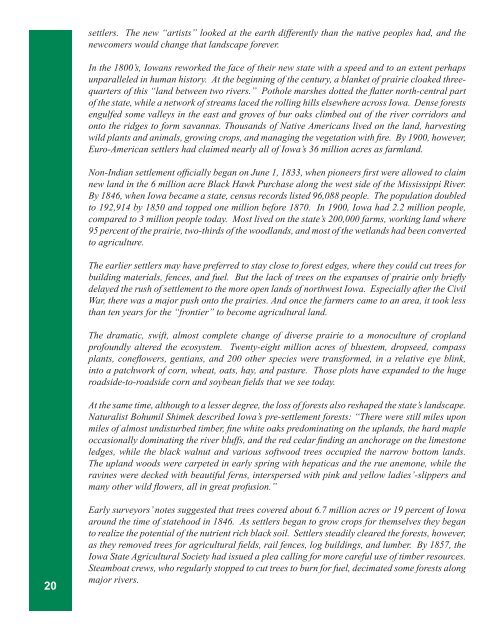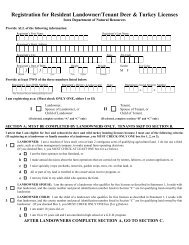IOwA'S FOREStS TOdAy - Iowa Department of Natural Resources
IOwA'S FOREStS TOdAy - Iowa Department of Natural Resources
IOwA'S FOREStS TOdAy - Iowa Department of Natural Resources
Create successful ePaper yourself
Turn your PDF publications into a flip-book with our unique Google optimized e-Paper software.
settlers. The new “artists” looked at the earth differently than the native peoples had, and the<br />
newcomers would change that landscape forever.<br />
In the 1800’s, <strong>Iowa</strong>ns reworked the face <strong>of</strong> their new state with a speed and to an extent perhaps<br />
unparalleled in human history. At the beginning <strong>of</strong> the century, a blanket <strong>of</strong> prairie cloaked threequarters<br />
<strong>of</strong> this “land between two rivers.” Pothole marshes dotted the flatter north-central part<br />
<strong>of</strong> the state, while a network <strong>of</strong> streams laced the rolling hills elsewhere across <strong>Iowa</strong>. Dense forests<br />
engulfed some valleys in the east and groves <strong>of</strong> bur oaks climbed out <strong>of</strong> the river corridors and<br />
onto the ridges to form savannas. Thousands <strong>of</strong> Native Americans lived on the land, harvesting<br />
wild plants and animals, growing crops, and managing the vegetation with fire. By 1900, however,<br />
Euro-American settlers had claimed nearly all <strong>of</strong> <strong>Iowa</strong>’s 36 million acres as farmland.<br />
Non-Indian settlement <strong>of</strong>ficially began on June 1, 1833, when pioneers first were allowed to claim<br />
new land in the 6 million acre Black Hawk Purchase along the west side <strong>of</strong> the Mississippi River.<br />
By 1846, when <strong>Iowa</strong> became a state, census records listed 96,088 people. The population doubled<br />
to 192,914 by 1850 and topped one million before 1870. In 1900, <strong>Iowa</strong> had 2.2 million people,<br />
compared to 3 million people today. Most lived on the state’s 200,000 farms, working land where<br />
95 percent <strong>of</strong> the prairie, two-thirds <strong>of</strong> the woodlands, and most <strong>of</strong> the wetlands had been converted<br />
to agriculture.<br />
The earlier settlers may have preferred to stay close to forest edges, where they could cut trees for<br />
building materials, fences, and fuel. But the lack <strong>of</strong> trees on the expanses <strong>of</strong> prairie only briefly<br />
delayed the rush <strong>of</strong> settlement to the more open lands <strong>of</strong> northwest <strong>Iowa</strong>. Especially after the Civil<br />
War, there was a major push onto the prairies. And once the farmers came to an area, it took less<br />
than ten years for the “frontier” to become agricultural land.<br />
The dramatic, swift, almost complete change <strong>of</strong> diverse prairie to a monoculture <strong>of</strong> cropland<br />
pr<strong>of</strong>oundly altered the ecosystem. Twenty-eight million acres <strong>of</strong> bluestem, dropseed, compass<br />
plants, coneflowers, gentians, and 200 other species were transformed, in a relative eye blink,<br />
into a patchwork <strong>of</strong> corn, wheat, oats, hay, and pasture. Those plots have expanded to the huge<br />
roadside-to-roadside corn and soybean fields that we see today.<br />
At the same time, although to a lesser degree, the loss <strong>of</strong> forests also reshaped the state’s landscape.<br />
<strong>Natural</strong>ist Bohumil Shimek described <strong>Iowa</strong>’s pre-settlement forests: “There were still miles upon<br />
miles <strong>of</strong> almost undisturbed timber, fine white oaks predominating on the uplands, the hard maple<br />
occasionally dominating the river bluffs, and the red cedar finding an anchorage on the limestone<br />
ledges, while the black walnut and various s<strong>of</strong>twood trees occupied the narrow bottom lands.<br />
The upland woods were carpeted in early spring with hepaticas and the rue anemone, while the<br />
ravines were decked with beautiful ferns, interspersed with pink and yellow ladies’-slippers and<br />
many other wild flowers, all in great pr<strong>of</strong>usion.”<br />
20<br />
Early surveyors’ notes suggested that trees covered about 6.7 million acres or 19 percent <strong>of</strong> <strong>Iowa</strong><br />
around the time <strong>of</strong> statehood in 1846. As settlers began to grow crops for themselves they began<br />
to realize the potential <strong>of</strong> the nutrient rich black soil. Settlers steadily cleared the forests, however,<br />
as they removed trees for agricultural fields, rail fences, log buildings, and lumber. By 1857, the<br />
<strong>Iowa</strong> State Agricultural Society had issued a plea calling for more careful use <strong>of</strong> timber resources.<br />
Steamboat crews, who regularly stopped to cut trees to burn for fuel, decimated some forests along<br />
major rivers.

















